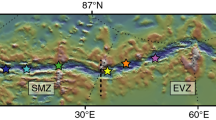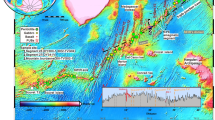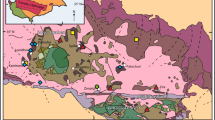Abstract
Phenocryst assemblages in ocean-ridge basalts generally show an increasing proportion of plagioclase as the total amount of phenocrysts increases. The variations in phase assemblages, as well as most crystal-liquid Kd's, are similar to variations (equimodal trends) predicted by low-pressure laboratory experiments, suggesting that many of these basalts have experienced varying degrees of low-pressure cyrstallization prior to quenching, with little sorting of crystals and liquid. Important exceptions include moderately to highly phyric basalts enriched either in plagioclase or olivine which lie well off the experimental trends. In these basalts, megacrysts and xenocrysts usually cited as evidence for magma mixing commonly represent a small proportion of the total crystalline phase assemblage. However, phase proportions for many of these basalts lie well outside the range that could be produced by simple mixing; selective gravitative sorting either prior or subsequent to mixing appears to be the likely explanation for these phyric basalts. A relation between spreading rate and phase proportions is neither supported nor refuted by the data, which as yet do not adequately represent fast-spreading ridges.
Pyroxene-phyric varieties are especially common among LIL-element enriched (Group 2) basalts, and these basalts also show the greatest abundance of olivine-enriched (picritic) samples. Selective enrichment in plagioclase is more common among LIL-element depleted (Group 1) basalts, and pyroxene appears in Group 1 basalts only at relatively high degrees of crystallinity. These differences are consistent with expected compositional effects (including volatiles) on phase boundaries, as well as likely differences in depth (pressure) of mantle melting and magma fractionation.
Sparsely to moderately phyric basalts tend to contain only olivine (±spinel) as phenocrysts, and lie in the olivine field in the projection from plagioclase in the CMAS tetrahedron. This is consistent with the concept that these magmas approach low-pressure equilibrium by olivine fractionation from a more picritic parent. The origin of these basalts, and relationships between them, remains an important fundamental problem.
Phenocryst phase assemblages are consistent with the low-pressure phase saturation indicated by the projected positions of the associated glasses in CMAS. It is suggested that, in contrast to the classical practice of classifying basalts according to phase proportions, a classification based on presence and/or first appearance of each crystalline phase is both practical and petrogenetically significant for water-quenched submarine basalts.
Similar content being viewed by others
References
Arcyana (1977) Rocks collected by bathyscaph and diving saucer in the FAMOUS area of the Mid-Atlantic Ridge rift valley: Petrologic diversity and structural setting. Deep-Sea Research 24, 565–589
Bence AE, Bayliss DM, Bender JF, Grove TL (1979) Controls on the major and minor element chemistry of Mid-Ocean Ridge Basalts and glasses. In: Talwani M, Harrison CG, Dennis DE. Proc 2nd Maurice Ewing Symposium, Am Geophys Union: 331–341
Bender JF, Hodges FN, Bence AE (1978) Petrogenesis of basalts from the project FAMOUS area: Experimental study from 0 to 15 kbars. Earth Planet Sci Lett 41:277–302
Benhamou G, Biggar GM (1978) Melting experiments of Mid-Atlantic Ridge basalts. In: MacKenzie WS, ed., Progress in Experimental Petrology, 11:202–204
Biggar GM, Kadik A (1981) Phase relations of two ocean basalts at atmospheric pressure. In: Ford CE. Progress in Experimental Petrology, 18:122–126
Bougault H, Hekinian R (1974) Rift Valley in the Atlantic Ocean near 36°50′N, petrology and geochemistry of basaltic rocks. Earth Planet Sci Lett, 24:249–261
Bryan WB (1979) Regional variation and petrogenesis of basalt glasses from the FAMOUS area, Mid-Atlantic Ridge, J Petrol, 20:293–325
Bryan WB, Thompson G, Frey FA, Dickey JS (1976) Inferred geologic settings and differentiation in basalts from the Deep Sea Drilling Projecct, J Geophys Res 81:4285–4304
Bryan WB, Moore JG (1977) Compositional variation of young basalts in the Mid-Atlantic Ridge rift valley near 36°49′N. Bull Geol Soc Am 88:556–570
Bryan WB, Thompson G (1977) Basalts from DSDP leg 37 and the FAMOUS area: compositional and petrogenetic comparisons. Can J Earth Sci 14:875–885
Bryan WB, Thompson G, Michael PJ (1979) Compositional variation in a steady state zoned magma chamber: Mid-Atlantic Ridge at 36°50′N. Tectonophys 55:63–85
Bryan WB, Thompson G, Ludden JN (1981) Compositional variation in normal MORB from 22–24°N, Midd-Atlantic Ridge and Kane Fracture Zone. J Geophys Res 86:11815–11836
Bryan WB, Dick HJB (1982) Contrasted abyssal basalt liquidus trends: evidence for mantle major element heterogeneity. Earth Planet Sci Lett, 58:15–26
Byerly G (1980) The nature of differentiation trends in some volcanic rocks from the Galapagos spreading center. J Geophys Res 85:3797–3810
Dick HJB, Bryan WB (1978) Variation of basalt phenocryst mineralogy and rock compositions in DSDP hole 396 B. In: Initial Reports of the Deep Sea Drilling Project, 46:215–225
Dixon S, Rutherford MJ (1979) Plagiogranites as late-stage immiscible liquids in ophiolite and mid-ocean ridge suites: an experimental study. Earth Planet Sci Lett 45:45–60
Donaldson CH, Brown RW (1977) Refractory megacrysts and magnesium-rich melt inclusions within spinel in oceanic tholeiites: Indicators of magma mixing and parental magma composition. Earth Planet Sci Lett 37:81–89
Dungan MA, Long PE, Rhodes JM (1978a) The petrography, mineral chemistry, and one-atmosphere phase relations of basalts from site 395. In: Initial Reports of the Deep Sea Drilling Project, 45:461–477
Dungan MA, Rhodes JM, Long PE, Blanchard DP, Brannon JC, Rodgers KV (1978b) The petrology and geochemistry of basalts from site 396 legs 45 and 46 of the Deep Sea Drilling Project. In: Initial Reports of the Deep Sea Drilling Project, 46:89–113
Fisk MR, Schilling J-G, Sigurdsson H (1980) An experimental investigation of Iceland and Reykjanes Ridge tholeiites: I. Phase relations. Contrib Mineral Petrol 74:361–374
Fisk MR, Bence AE, Schilling J-G (1982) Major element chemistry of Galapagos Rift Zone magmas and their phenocrysts Earth Planet. Sci Lett 61:171–189
Flower MFJ (1980) Accumulation of calcic plagioclase in oceanridge tholeiite: an indication of spreading rate. Nature 287:530–532
Flower MFJ, Robinson PT (1979) Evolution of the ‘FAMOUS’ ocean ridge segment: Evidence from submarine and deep sea drilling investigations. In Deep Drilling Results in the Atlantic Ocean: Ocean Crust. Maurice Ewing Series, vol 2, M Talwani ed, p 314–330
Fujii T, Kushiro I (1977) Melting relations and viscosity of an abyssal tholeiite. Carn Inst Wash Yearb 76:461–462
Fukuyama H, Hamuro K (1978) Melting relations of leg 46 basalts at atmospheric pressure. In: Initial Reports of the Deep Sea Drilling Project, 46:235–239
Green DH, Hibberson WD, Jaques AL (1979) Petrogenesis of midocean ridge basalts. In: McElhinny MW, ed, The Earth: Its origin, structure, and evolution. Academic Press, London
Hekinian R, Moore J-G, Bryan WB (1976) Volcanic rocks and processes of the Mid-Atlantic Ridge rift valley near 36°49′N. Contrib Mineral Petrol, 58:83–110
Hermes OD, Schilling J-G (1976) Olivine from Reykjanes Ridge and Iceland tholeiites and its significance to the two-mantle source model. Earth Planet. Sci Lett 28:345–355
Hodges FN (1978) Petrology and chemistry of basalts from DSDP leg 46. In: Initial Reports of the Deep Sea Drilling Project 46:227–233
Juteau T, Cyamex Scientific Team (1980) Homogeneous basalts from the East Pacific Rise at 21°N: Steady state magma reservoirs at moderately fast spreading centers. Oceanol Acta 3:487–503
Kuo LC, Kirkpatrick RJ (1982) Pre-eruption history of phyric basalts from DSDP Legs 45 and 46: Evidence from morphology and zoning patterns in plagioglase. Contrib Mineral Petrol 79:13–27
Kushiro I (1973) Origin of some magmas in oceanic and circumoceanic regions. Tectonophys 17:211–222
Kushiro I (1975) On the nature of silicate melt and its significance in magma genesis: regularities in the shift of the liquidus boundaries involving olivine, pyroxene, and silica minerals. Am J Sci 275:411–431
Langmuir CH, Bender JF, Bence AE, Hanson GN, Taylor SR (1977) Petrogenesis of basalts from the FAMOUS area, Mid-Atlantic Ridge. Earth Planet Sci Lett 36:133–156
Melson WG, O'Hearn TO (1979) Basaltic glass erupted along the Mid-Atlantic Ridge between 0°–37°N: Relationship between composition and latitude. In: Deep Sea Drilling Results in the Atlantic Ocean: Ocean Crust. Maurice Ewing Series, vol 2, M Talwani ed, p 249–261. AGU, Washington, DC
Moore JG (1979) Vesicularity and CO2 in mid-ocean ridge basalt. Nature 282:250–253
Natland JH, Melson WG (1980) Compositions of basaltic glasses from the East Pacific Rise and Siqueiros Fracture Zone, near 9°N. In: Initial Reports of the Deep Sea Drilling Project 54:705–723
O'Donnell TH, Presnall DC (1980) Chemical variations of the glass and mineral phases in basalts dredged from 25–30°N along the Mid-Atlantic Ridge. Am J Sci 280A:845–868
O'Hara MJ (1976) Percentage crystallinity and calculated liquid composition in experimental samples. In: MacKenzie WS ed, Progress in Experimental Petrology, 1972–1975. Nat Env Res Council Pub 6:194–195
Presnall DC, Dixon JR, O'Donnell TH, Dixon SA (1979) Generation of Mid-ocean ridge tholeiites. J Petrol 20:3–35
Rhodes JM, Dungan MA, Blanchard DP, Long PE (1979) Magma mixing at mid-ocean ridges: Evidence from basalts drilled near 22°N on the Mid-Atlantic Ridge. Tectonophys 55:35–61
Sato H, Aoki K, Okamoto K, Fujita B (1978) Petrology and geochemistry of basaltic rocks from hole 396B, IPOD/DSDP leg 46. In: Initial Reports of The Deep Sea Drilling Project 46:115–141
Schilling J-G, Kingsley RH, Devine JD (1982) Galapagos hot-spot spreading center system, 1. Spatial petrological and geochemical variations, (83°W–101°W). J Geophys Res 87:5593–5610
Schilling J-G, Zajai M, Evans R, Johnston T, White W, Devine JD, Kingsley R (1983) Petrologic and geochemical variations along the Mid-Atlantic Ridge from 29°N to 73°N. Am J Sci, in press
Shibata T (1976) Phenocryst-bulk rock composition relations of abyssal tholeiites and their petrogenetic significance. Geochim Cosmochim Acta 40:1407–1417
Shibata T, Thompson G, Frey FA (1979) Tholeiitic and alkali basalts from the Mid-Atlantic Ridge at 43°N. Contrib Mineral Petrol 70:127–141
Shido F, Miyashiro A, Ewing M (1971) Crystallization of abyssal tholeiites. Contrib Mineral Petrol 31:251–266
Shido F, Miyashiro A, Ewing M (1974) Compositional variation in pillow lavas from the Mid-Atlantic Ridge. Marine Geol, 16:177–190
Sigurdsson H (1981) First-order major element variation in basalt glasses from the Mid-Atlantic Ridge: 29°N to 73°N. J Geophys Res 86:9483–9502
Staudigel H, Bryan WB (1981) Contrasted glass-whole rock compositions and phenocryst re-distribution, IPOD sites 417 and 418. Contrib Mineral Petrol 78:359–371
Stolper E (1980) A phase diagram for mid-ocean ridge basalts: Preliminary results and implications for petrogenesis. Contrib Mineral Petrol 74:13–27
Tilley CE, Thompson RN, Lovenbury PA (1972) Melting relations of some oceanic basalts. Geol J 8:59–64
Walker D, Shibata T, DeLong SE (1979) Abyssal tholeiites from the Oceanographer Fracture Zone. II. Phase equilibria and mixing. Contrib Mineral Petrol 70:111–125
Wilkinson JFG (1982) The genesis of mid-ocean ridge basalt. Earth Sci Rev 18:1–57
Author information
Authors and Affiliations
Additional information
Woods Hole Oceanographic Institution Contribution No. 5342
Rights and permissions
About this article
Cite this article
Bryan, W.B. Systematics of modal phenocryst assemblages in submarine basalts: Petrologic implications. Contr. Mineral. and Petrol. 83, 62–74 (1983). https://doi.org/10.1007/BF00373080
Accepted:
Issue Date:
DOI: https://doi.org/10.1007/BF00373080




